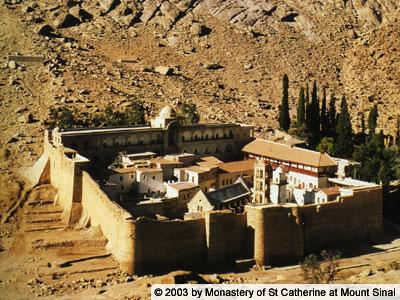The “oldest continuously inhabited Christian monastery” in the world, the Holy Monastery of the God-trodden Mount Sinai, St Catherine’s, was waiting with bated breath last week to find out whether it would be able to reopen its doors to tourists, upon which it depends for essential income and outreach.
Sheikh Mousa al-Gebaly, a local hotelier and member of the Bedouin tribe that hosts most of the tourist trade in St Catherine, told the Guardian,
“It was expected to reopen on the 13th or the 15th of this month,” said Sheikh al-Gebaly. “But after today’s bombings in Cairo we worry that the curfew and the state of emergency will remain and the monastery will be forced to close for longer.”
There may be little relief in sight for the monastery and its surrounding community, after a weekend in which the Egyptian government mistakenly targeted a group of Mexican tourists and their guides for airstrikes, killing 12 people.
At the monastery, the monks are worried.
It is now open for services, but not for tours or overnight guests – causing a drop in revenue that means the monks will soon be unable to pay the monastery’s 400-strong workforce, which is drawn from the local population, and which helps maintain the site’s farms and olive groves.
“It’s very bad,” said Ahmed Mohamed, an assistant manager at a hostel on the site. “The monastery doesn’t have the money to pay for the Bedouin who work inside the monastery.”
Father Paolos, a priest at St Catherine since 1972, told the website al-Monitor: “Despite having more time to pray and practise, our priests live without crowds of visitors. We are suffering a major financial crisis, and we cannot cover the monastery’s expenses and dozens of families that we constantly support.
The government ordered the monastery closed to visitors after attacks on Christian churches and sites followed the removal of Mohamed Morsi as president of the country in July; but the people of St Catherine argue that their site is different.
Arguments broke out between monks and villagers after it was closed, but only because the latter wished to see it reopen. “For the people here, the monastery is everything,” said Khadr. “We grew up with the monastery – it’s our history, our roots.”
The monastery’s website describes that heritage:
The Greek Orthodox monastery of the God-trodden Mount Sinai is located at the very place where God appeared to Moses in the Burning Bush, beneath the Mount of the Decalogue…
The monastery can be thought of as a veritable Ark for its spiritual treasures. These include the manuscripts and early printed books preserved in the Sinai library, which is celebrated throughout the world for the antiquity and importance of its volumes. It also includes the monastery icons….
The monastery has been honoured by rulers throughout its history. These include the Empress Helena, the Emperor Justinian, Mohammed the Founder of Islam, Sultan Selim I, the Empress Catherine of Russia, and Napoleon Bonaparte. Contemporary heads of state have continued to show their interest in the monastery. …. It has been revered not only by Christians, but also by Moslems and Jews. It has recently been listed by UNESCO as a World Heritage Site, both for its cultural and for its scenic significance.
The monks of Sinai, from earliest times until the present day, maintain a dedication both to prayer and to the support of pilgrims and visitors. They live at peace with the native Bedouin. They maintain the ancient spiritual heritage of Sinai, a heritage that extends from the giving of the Law, through the whole of the Old and New Testaments, to the multitude of saints whose memory has been enshrined at Sinai – above all, to the All-holy Theotokos, to the holy prophets Moses and Elias, and to Saint Catherine.
The website makes no mention of the recent troubles and closure, and so it is unclear when the monastery will be free to reopen its doors to visitors. Find the Guardian‘s story on the closure here. Photo via St Catherine’s website.

